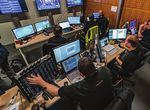CASE STUDY - RIEDEL Communications
←
→
Page content transcription
If your browser does not render page correctly, please read the page content below
CASE STUDY
Providing a World-Class Signal
and Communications Backbone
for the Eurovision Song Contest
Continuing a 13-year tradition, Riedel Communications supplied a massive, all-fiber
communications and signal distribution system for the 2018 Eurovision Song Contest,
the world’s longest-running international television song competition.
The 63rd annual contest was broadcast live from the Altice Arena in Lisbon, Portugal, with
Riedel’s MediorNet real-time media network providing redundant and decentralized signal
routing and transport from start to finish. Through tight integration with MediorNet, Riedel’s
Artist digital matrix intercom system and Bolero wireless intercom provided comprehensive
and reliable communications for crew and performers.
Over its six-decade history, the Eurovision Song Contest has become one of the most-
watched nonsporting events in the world, with the 2018 broadcast reaching an estimated
global audience of 200 million. For all three broadcasts, including the semifinal on May 8th
and 10th and the finals on May 12th, Riedel supplied the signal and communications back-
bone for Videohouse, which produced the show’s world feed on behalf of EBU and Portu-
gal’s public broadcasting company, RTP.CASE STUDY: EUROVISION SONG CONTEST
“Pretty much every single OB
truck in Europe that is big enough
to do the Eurovision Song Con-
test, has a Riedel main frame in-
stalled. We had a one stop shop
for our digital signal ecosystem. WHY RIEDEL?
It was absolutely perfect!” “I was heavily involved with setting up a
long-term contract between EBU and
Riedel,” said Ola Melzig, Head of Produc-
tion for the 2018 Eurovision Song Contest.
Ola Melzig / Head of Production / Eurovision Song Contest
“Pretty much every single OB truck in
Europe that is big enough to do a Eurovision, has a Riedel main frame installed. This means
that everything you connect to this truck needs to be Riedel gear, for it to be 100 percent
compatible. So, since the delivery of radios, intercom panels, commentator panels, ac-
creditation, fiber backbone, and signal distribution are static from year to year, it made all
the sense in the world to set up this deal, since it generates significant savings both for this
year’s host broadcaster, and future ones. In addition to that package, we also bought the
whole IT solution from Riedel, so we had a one stop shop for our digital ecosystem. It was
absolutely perfect!”
THE BACKBONE
The Riedel MediorNet backbone consisted of six MetroN core routers, 24 MediorNet modu-
lar frames, and 30 MicroN high-density media distribution network devices. Deployed in a
decentralized configuration, the MediorNet network ensured fully redundant distribution of
all video and audio signals for commentary, intercom, signal distribution, and radio com-
munications, including the feeds for monitors in commentary booths and for displays and
projectors in the Altice Arena.
ADD IN BROADCAST BOOTHS AND CREW COMMUNICA-
TIONS
The Riedel Communications Control Room connected over
800 intercom users For the first time at the Eurovision Song Contest, Riedel deployed a complete solution
based on Session Initiation Protocol (SIP) to support commentary booths for almost 30
countries covering the contest for their local audiences. Anchored by four Artist 64 intercom
mainframes and 40 Artist CCP-1116 commentary panels, the system used Cymatic Audio’s
uTrack24 devices, loaded with Angelbird SSD hard drives, to manage line IDs for the com-
mentary booths.
Crew communications were facilitated by a robust intercom system anchored by four more
Artist 64 mainframes and more than 100 Artist RCP and DCP intercom panels. The Artist
panels provided fully redundant, decentralized distribution of all Bolero wireless intercom
signals, with 32 Bolero beltpacks deployed to the production team. Bolero’s Advanced DECT
Receiver (ADR) technology ensured clear communications throughout the Altice Arena using
only six AES67-networked antennas. The Artist infrastructure also supported almost 600
Hytera and Motorola TETRA handheld radios.
Thomas Riedel and Jon Ola Sand, Executive Supervisor of the
Eurovision Song Contest for EBUEach blue rectangle represents a MediorNet Node. More
than 60 in total were needed to build the comprehensive
signal backbone required for the ESC.
“...more than 5,000 buttons spread
across 200 comms panels, over 800
intercom users, and a record-break-
ing 46 km of fiber-optic cable.”
Benedikt Leister / Project Manager / Riedel Communications
IT’S NOT JUST ABOUT BROADCASTING WRAPPING IT UP
ANYMORE “The Eurovision Song Contest has become a massive undertaking,
but our team lives for this type of large-scale, immensely complex
In addition, DECA, a Riedel subsidiary, provided an access con-
challenge. To really appreciate what Riedel and Videohouse pulled
trol system designed to simplify guest and crew entry into the
off for this year’s show, take a look at some of the numbers — more
arena, boost security, and provide efficient visitor management.
than 5,000 buttons spread across 200 comms panels, over 800
The system required personnel to pass through turnstiles where
intercom users, and a record-breaking 46 km of fiber cable,” said
their accreditation cards, embedded with RFID chips, were swiped
Benedikt Leister, Project Manager at Riedel Communications. “We
with stationary or wireless reading devices, and the RFID data was
can’t wait to see what the producers have in store for next year, but
matched to an online database. Also, Riedel worked with partner
we’re confident that our MediorNet, Artist, and Bolero technologies
TPO to provide a comprehensive IT and cybersecurity infrastruc-
will be up to the task and provide the robust and reliable infrastruc-
ture, including all switches, servers, and 170 wireless access points,
ture needed to deliver a dazzling and memorable show.”
for up to 2,000 journalists in the press center.You can also read






















































